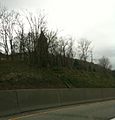Pennsylvania Turnpike facts for kids
Quick facts for kids
Pennsylvania Turnpike |
|||||||
|---|---|---|---|---|---|---|---|
| Lua error in Module:Infobox_road/map at line 15: attempt to index field 'wikibase' (a nil value).
The East–West Mainline of the Pennsylvania Turnpike system
|
|||||||
| Route information | |||||||
| Maintained by Pennsylvania Turnpike Commission | |||||||
| Length | 360.091 mi (579.510 km) | ||||||
| Existed | October 1, 1940–present | ||||||
| Major junctions | |||||||
| West end | |||||||
|
|||||||
| East end | |||||||
| Highway system | |||||||
| Roads in Pennsylvania Interstate • US • State • Legislative
|
|||||||
The Pennsylvania Turnpike is a toll road. This means drivers pay money to use it. The Pennsylvania Turnpike Commission runs this road in Pennsylvania, United States. It is a special kind of road called a limited-access highway. This means cars can only get on and off using ramps.
The turnpike stretches about 360 miles (580 km) across the state. It starts at the Ohio border in Lawrence County. There, it connects to the Ohio Turnpike. The road ends at the New Jersey border in Bucks County. This is at the Delaware River – Turnpike Toll Bridge over the Delaware River. On the New Jersey side, it becomes part of the New Jersey Turnpike.
The turnpike goes from west to east through Pennsylvania. It passes near big cities like Pittsburgh, Harrisburg, and Philadelphia. As it crosses the Appalachian Mountains, it goes through four tunnels. The Pennsylvania Turnpike is also part of the Interstate Highway System. Parts of it are known as Interstate 76 (I-76), I-70, and I-276.
Drivers pay tolls using a ticket system on most of the road. You get a ticket when you enter and pay when you leave. There are also special toll plazas that use cameras to read license plates. They send a bill to your home. You can also use E-ZPass, which is an electronic way to pay tolls.
Contents
History of the Pennsylvania Turnpike
The idea for the Pennsylvania Turnpike came about in the 1930s. People wanted an easier way to drive across the mountains in Pennsylvania. The road used seven tunnels that were originally built for a railroad back in the 1880s.
Opening the First Section
The first part of the turnpike opened on October 1, 1940. This section ran between Irwin and Carlisle. It was the first long-distance limited-access highway in the United States. This success helped inspire the building of other toll roads and the entire Interstate Highway System.
Expanding the Turnpike
After World War II, the turnpike was made longer.
- In 1950, it was extended east to Valley Forge.
- In 1951, it was extended west to the Ohio border.
- In 1954, the road was built further east to the Delaware River.
- The main part of the turnpike was finished in 1956 when the Delaware River bridge was built.
Modernizing the Road
In the 1960s, big changes were made to the tunnels. Another tunnel tube was dug next to four of the old two-lane tunnels. This made them four lanes wide. The other three tunnels were closed, and new roads were built around them. This made the entire turnpike four lanes wide.
Today, work continues to make the road even better. Older sections are being rebuilt to modern standards. Some parts of the turnpike are being widened to six lanes. New places to get on and off the road (called interchanges) are also being added.
Images for kids
See also
 In Spanish: Pennsylvania Turnpike para niños
In Spanish: Pennsylvania Turnpike para niños






























